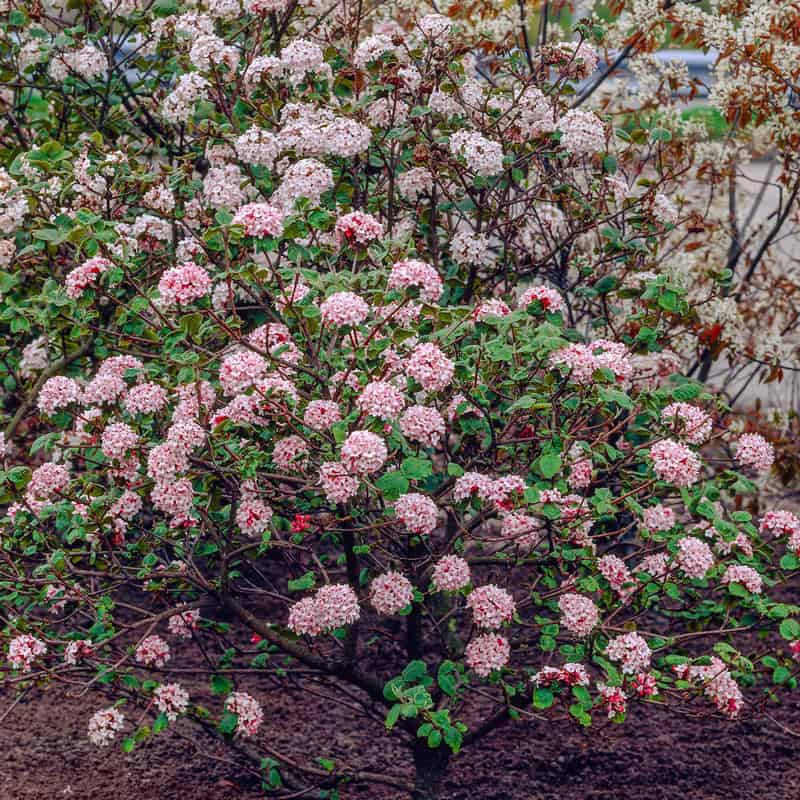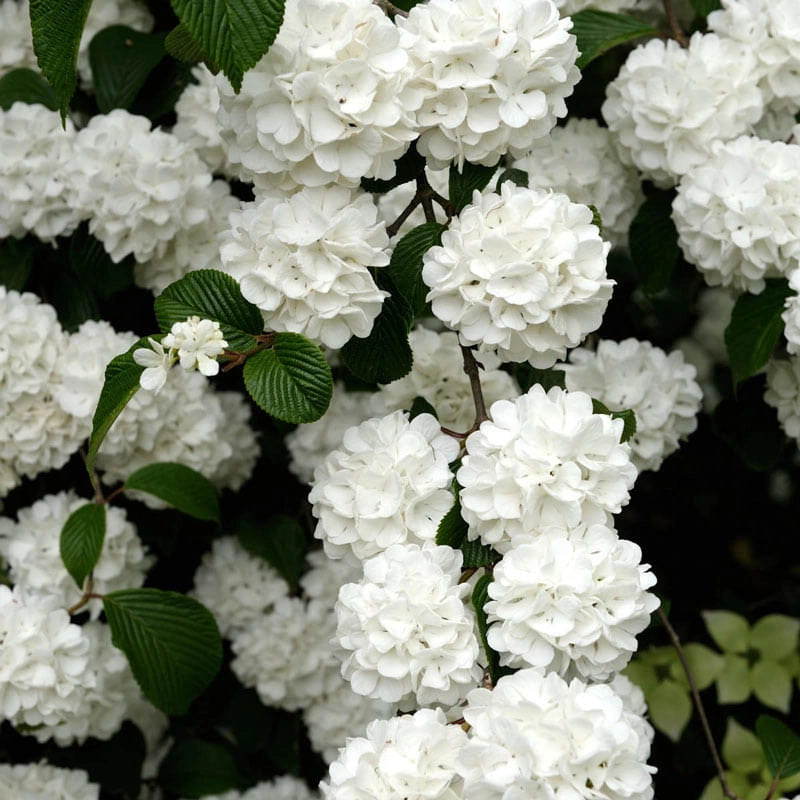3 products
These features make viburnum bushes ideal for anyone who wants to make their garden beautiful, or anyone who wants an aesthetically pleasing privacy bush. Expect this plant to look beautiful and distinctive no matter the season. Viburnum bushes also feature ornamental berries.
What does a viburnum bush look like?
Viburnum shrubs are ornamental in every sense of the word— from their leaves and blossoms to their decorative berries, they're sure to fill in your landscape with an arrangement of colors. Most viburnum bushes feature bright red berries and a rich display of white, pink or ivory blooms, alongside bright green foliage that turns to a stunning red display in autumn. The foliage of viburnum is dependent upon the cultivar, and may range from smooth and rounded to tough and tooth–edged. Maple–like varieties are particularly popular with gardeners looking to add autumn color to their landscapes. Viburnums also grow in a wide variety of sizes. Many types of viburnum grow in a compact shape and reach just a few feet in height, while other varieties can reach up to 20 feet.
Some cultivars of viburnum look like hydrangeas, due to their snowball–shaped flowers that bloom in dome– or globe–shaped clusters. Others have flat–topped flower clusters, more reminiscent of the form of a spirea or dogwood shrub. However they grow, viburnum are truly unique shrubs, with a dense growth habit, unique floral structure, and three–season show that simply can't be compared.
How to grow viburnum bush:
Viburnum are highly adaptable, easy–to–grow shrubs. Many are native to North America, making them well–suited to American gardens. In order to grow a viburnum bush successfully, think ahead when choosing a site and provide the bush plenty of room to grow. Most viburnums prefer full sun, and having plenty of airflow prevents disease among these plants. Choose a viburnum that will fit your space at its mature size, and avoid planting large varieties near buildings or other trees. Viburnums aren't particularly picky about soil, but you should select a well–draining location.
While thinking about site selection, also consider whether you want to cross–pollinate your viburnum. Most viburnum plants are not self–pollinating, which means that you'll need to plant multiples if you want your shrubs to develop a good amount of fruit. In general, viburnum need genetic diversity to pollinate, meaning that the plants pollinate best when they are grown alongside diverse plants of the same species. So, pair your viburnum shrubs with other types of viburnum, and locate them within close enough proximity that pollinating insects can do their work.
Viburnums prefer slightly acidic soil, so you'll only need to amend your growing area if your soil tends to be alkaline or contains heavy clay. After planting your shrub, mulch around its base to help retain moisture, and water it regularly through its first year. After each blooming season, using a balanced fertilizer will help the plant prepare for winter.
The most complicated piece of viburnum care comes with pruning—and, with regular yearly pruning, this task isn't particularly difficult. Pruning accomplishes three major goals. With regular trimming, you're preventing legginess, maintaining a tidy shape, and providing regular airflow around the plant. Prune your plant just after it flowers and before any threat of frost, and avoid removing more than one–third of its overall size. If possible, cut branches just above the node attaching branch to trunk, in order to encourage rebranching. Remove overgrown or spindly branches, and cut back any branches that are crossed or diseased. "Open up" airflow to the trunk by removing any old or unsightly branches near the base of the tree.
Most viburnum require little overwinter care and have no issue with cold hardiness. Apply a new layer of mulch in fall, and begin watering the plant again in the springtime.
How fast does viburnum grow?
Until several years ago, viburnum was actually classified in the same family as honeysuckle, due in part to its thick and fast growth capabilities. However, unlike honeysuckle, viburnum won't overtake your garden, and they're extremely amenable to pruning. Smaller varieties, such as Korean Spice viburnum, grow at a rate of about one foot per year. Taller varieties can grow at a rate double that, so these are a great option for quickly filling in your landscape. Luckily, viburnums are happy to be shaped and pruned. To maintain a tidy shape, you can prune back as much as one–third of your viburnum's size at the end of each growing season. Some gardeners train viburnum as trees by cutting from the bottom to create a trunk.
How much sun does a viburnum bush need ?
Although some types of viburnum are exceptional in their sun requirements, most viburnum bushes develop the best blooms and berries in full sun or partial shade. If you're planting in the southern United States, it may be beneficial to keep your viburnum in a location that receives less direct sunlight in hot afternoons.
When do viburnums bloom?
Viburnums are springtime bloomers. These shrubs take a few years to get established, so you may not see a torrent of blooms in the early years. After the first year or two of establishing itself in your landscape though, your viburnum will present you with a beautiful floral display. Expect flowers to appear for two to four weeks in late spring. These show stopping shrubs don't fade into the background when they're finished blooming either. You'll enjoy bright berries in the summer—sure to attract cardinals, cedar waxwings, and other songbirds. The bright and glossy green leaves make viburnums a standout shade plant in the warmer months. A few viburnum varieties remain evergreen, but most provide a beautiful display of stunning fall color in orange and scarlet. Viburnums are truly a shrub for all seasons.




